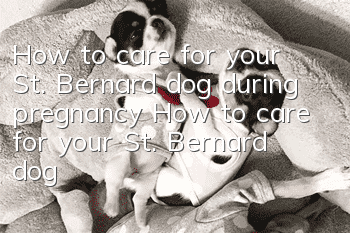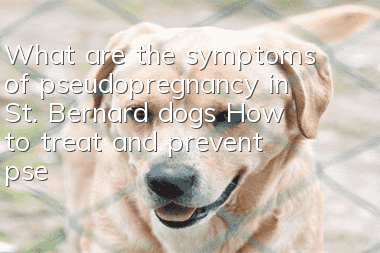How to care for St. Bernard dogs after giving birth. Tips on caring for St. Bernard dogs after giving birth.

How to care for St. Bernard dogs after giving birth? It is the first time for many poop scrapers to deliver babies to St. Bernard dogs, so how to deal with it? Below, Xiaodouzi will share with you the experience of postpartum care for St. Bernard dogs.
St. Bernard dog postpartum care experience:
1. Use warm water to clean the dirty parts of the St. Bernard dog’s body, especially the vagina. And wipe the breast and surrounding areas clean with warm water, and let the puppy get close to the Saint Bernard dog's breast. At this time, the Saint Bernard dog will instinctively lick the puppy's body, and the puppy will suck breast milk, so as to make every Saint Bernard dog's breast as close as possible. Bernese dogs can drink breast milk to obtain invisible antibodies from the mother dog, which enhances the puppy's resistance to disease;
2. Give the St. Bernard a quiet environment after giving birth. At this time, the maternal nature of the St. Bernard is the strongest, so do not let strangers or other animals approach to avoid aggressive behavior when the mother dog is guarding her pups.
3. At the same time, St. Bernard dogs should be given high-calorie, high-protein, high-fat and calcium-rich foods, such as puppy dog food, and an appropriate amount of calcium powder and Xiuguanfu Recreation should be added to regulate the intestinal tract of the female dog. function and accelerate recovery.
1. Mastitis
The so-called mastitis refers to the bacterial infection of one or more mammary glands, and the cause of the infection can be ascending infection of the nipple or infection due to trauma to the mammary gland. If mastitis infection is not properly treated, it may cause a fatal systemic infection.
Symptoms:
St. Bernard dogs with mastitis usually have a loss of appetite, poor energy, and neglect to take care of the puppies. The breasts are hard, swollen and warm when touched with hands. Most Saint Bernard dogs will feel pain, and pus-like blood-containing fluid will flow out of the nipples. In severe infections, there will be lesions such as thick sores or gangrene on the breasts, and St. Bernard dogs will have fever and dehydration.
2. Produce diarrhea
Definition:
The reason is that postpartum hypocalcemia leads to tonic and clonic contractions of skeletal muscles. This situation can be fatal. Please be careful! When puppies are ten or twenty days old, If the mother sucks too much milk, the bitch will lose serious calcium. Without proper calcium supplementation after giving birth, the bitch will be prone to childbirth fever.
Symptoms:
(1) Saint Bernard dogs will become restless and neurotic;
(2) Kick and breathe faster and whine;
(3) Stiffness in walking posture and movement disorders;
(4) Muscle tremors and twitching;
(5) However, 8-12 hours after the first symptoms occur, fatal symptoms of muscle stiffness, straightening, and falling to the ground may occur
Usually accompanied by a rise in body temperature, hypoglycemia and dilated pupils, which do not respond to light.
Treatment methods:
1. Antibacterial and anti-inflammatory, large doses of antibiotics can be used.
2. Inject glucose sodium chloride injection, vitamin C, and sodium hydrogen phosphate solution intravenously to correct dehydration and acidosis.
3. Calcium deficiency
(1) Diet is an essential thing every day. If you want to prevent St. Bernard dogs from calcium deficiency, you must start with their daily diet. In addition to eating a single dog food for St. Bernard dogs, you should also Pay attention to a reasonable diet for St. Bernard dogs. The calcium content in dog food is very small, and some even have no calcium content. You can appropriately give St. Bernard dogs some foods with higher calcium content, such as dried shrimps, soy products, etc. Give the Saint Bernard more vegetables and fruits to supplement vitamins. When supplementing calcium to the Saint Bernard, pay attention to the vitamin intake, so that the Saint Bernard can better absorb calcium.
(2) In the first few days of feeding, the principle of "eating less and more meals" should be followed, generally based on foods that are easy to digest and absorb, such as broth, porridge, milk, etc. It can be fed 3 to 4 times a day. In addition to appropriately increasing concentrates and vegetables, more meat, liver, bone soup, broth, eggs and milk should be fed to supplement calcium for the female dog.
(3) In order to achieve a better purpose of calcium supplementation, you can also choose professional pet calcium supplement products. In terms of effectiveness, liquid calcium is now generally recognized, followed by calcium powder, and finally calcium tablets.
(4) In addition, giving the Saint Bernard some sunshine can also help the Saint Bernard absorb calcium better. However, you should not bask in the sun for too long to prevent your St. Bernard dog from sunburn or heat stroke.
4. Lochia
When breastfeeding, you usually lie on your side. The vulva stays close to the bedding for a long time, so it is more likely to cause infection. Parents should regularly disinfect and clean the dog's mother's vulva and perineum. Lochia contains a large amount of blood and other substances that are easy for bacteria to grow, so it can cause ascending infection and must be wiped clean in time. Clinically, 0.1% potassium permanganate water is commonly used as a cleaning solution because it has strong oxidizing effect and is non-irritating.
For St. Bernard dogs with lochia and vaginal bleeding, postpartum fasting or Houttuynia cordata injection is required to promote uterine contraction. Going to the hospital is just like this, maybe the name is different. You can eat motherwort and brown sugar water after giving birth, which can warm and protect the uterus and help the mother dog recover quickly.
If the above situation occurs, please take your pet to the hospital for treatment as soon as possible. The doctor will give a slow intravenous injection to improve the hypocalcemia. If the body temperature is too high, cold water immersion and electric fans can be used to cool down to stabilize the St. Bernard Canine signs of life. In the future lactation period, sufficient calcium should be supplemented.
- When does a female Husky go into heat? Tips on caring for a female Husky during heat
- When is the best time to neuter a Husky? What are the advantages and disadvantages of neutering a Husky?
- What should I do if my Husky is in heat? What should I pay attention to?
- What should I do when my female dog is menstruating?
- How to care for a Twisted Bolton dog after giving birth. Tips for caring for a Twisted Boliton dog after giving birth.
- What to do if your Saint Bernard is in heat? What to do if your Saint Bernard is in heat?
- What should the Twisted Boliton dog eat after giving birth? Introduction to the Twisted Boliton dog’s diet after giving birth
- How to care for your American Water Spaniel after giving birth. How to care for your American Water Spaniel after giving birth.
- How to care for the Irish Terrier after giving birth. Tips on caring for the Irish Terrier after giving birth.
- What are the prenatal signs for the American Water Spaniel? What should you prepare for the American Water Spaniel before she gives birth?



